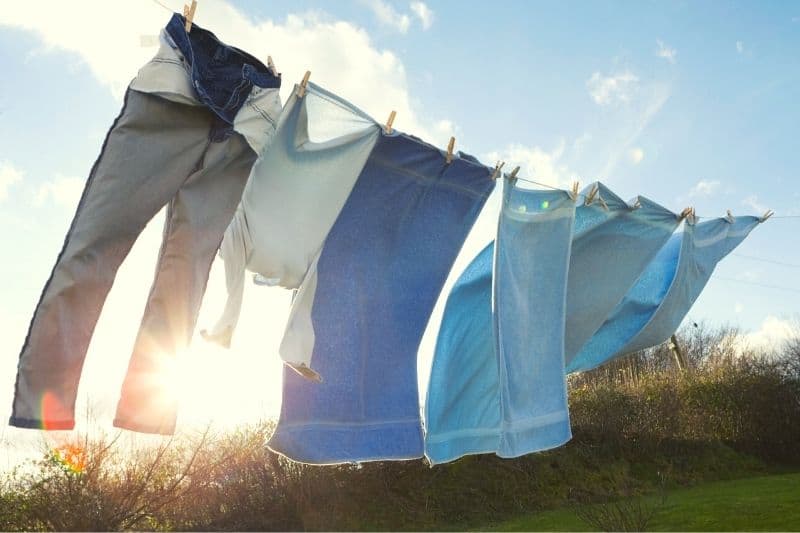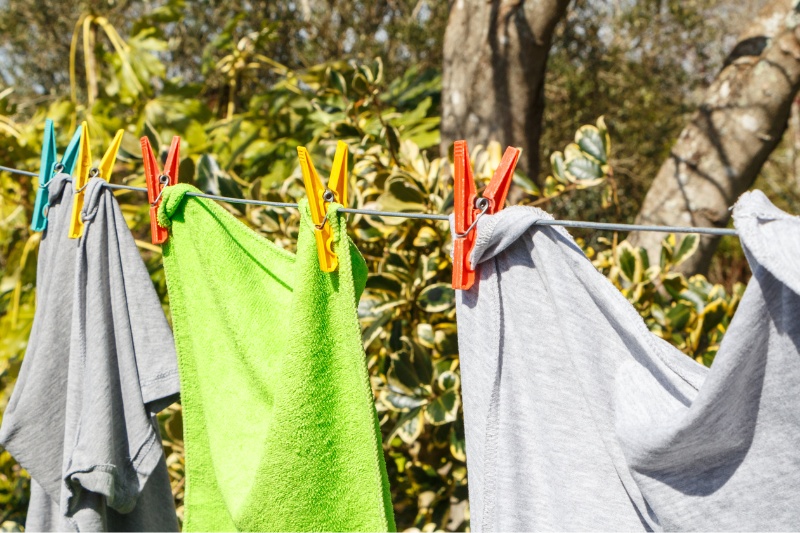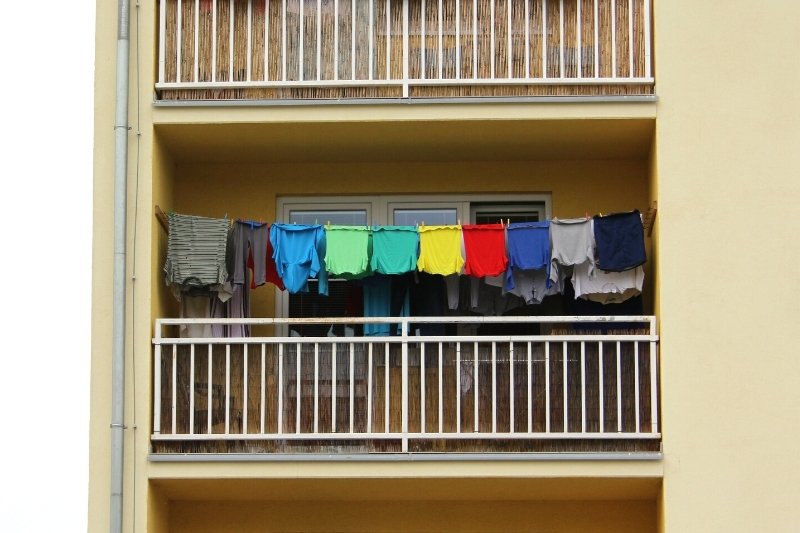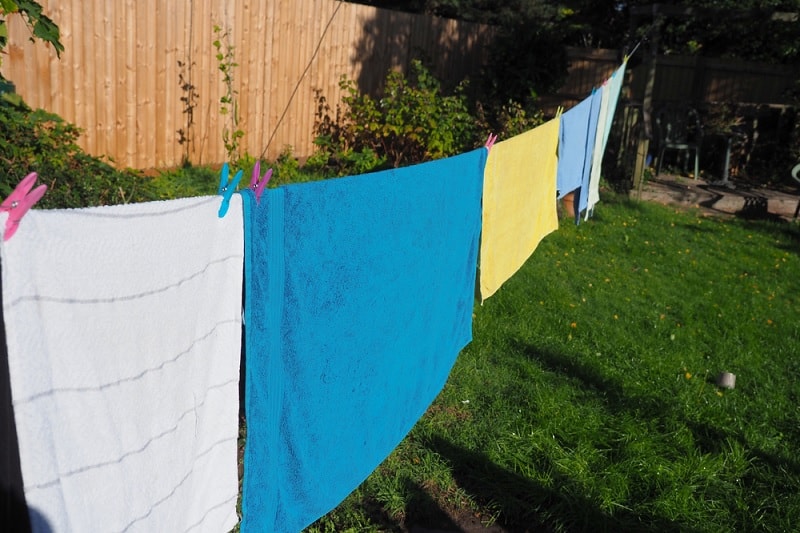Line drying simply refers to the practice of hanging wet laundry on a clothesline or clothes airer, for example, to allow the natural air and sunlight to dry the garments.
This practice predates the invention of electric clothes dryers, and it was once the primary method for drying clothes across the world.
With the advent of technology, line drying lost some of its popularity, but it has been making a comeback in recent years due to its numerous benefits.
Advantages of Line Drying

Free and eco
One of the most significant advantages of line drying is that it doesn’t cost anything (unless you use a heated airer).
While modern tumble dryers have a lower energy consumption than ever, they will never beat line drying.
By opting for line drying, you can drastically reduce your energy bills and contribute to a more sustainable future.
Garment longevity
Heat and tumbling in traditional dryers can cause wear and tear on fabrics over time.
Line drying, on the other hand, is gentler on clothes, helping to extend their lifespan and keeping them looking newer for longer.
Reduced environmental impact
Tumble dryers contribute to greenhouse gas emissions, primarily when powered by non-renewable energy sources.
By choosing to line dry, you’re directly reducing your carbon footprint and minimising the environmental impact of your laundry routine.
Natural freshness
Sunlight is a natural disinfectant and deodoriser. Line drying your clothes allows them to bask in the sun’s rays, eliminating odours and leaving your garments with a fresh, natural scent.
Whiter whites
Sunlight has a natural bleaching effect on fabrics, helping to keep white clothes looking their best. This is particularly beneficial for items like bed linens and towels.
Line Drying Techniques

Getting started with line drying is simple, but there are a few techniques to keep in mind to ensure your clothes dry efficiently and look their best.
Choose the right location
Find a spot with ample sunlight and good air circulation. This could be your back garden, balcony, or even an indoor drying rack placed near a sunny window.
Use proper hangers or pegs
Invest in sturdy clothes hangers or pegs designed for line drying. One of the benefits of drying clothes outside is the wind, but on windy days, you don’t want your pants blowing into your neighbour’s garden.
So, buying quality pegs or hangers prevents your clothes from falling to the ground and reduces the risk of creases.
Shake clothes before hanging
Give each garment a good shake before hanging it to release any wrinkles and help it dry more evenly.
Separate your clothes based on weight
Hang lightweight fabrics separately from heavier ones. This prevents lightweight items from getting crushed under the weight of wet, heavy clothes.
Smooth out wrinkles
While hanging, gently smooth out any wrinkles or folds in the fabric to help it dry with a neat appearance.
Doing this will all but eliminate the need to iron your clothes once they are dry, saving you even more energy and time.
Rotate and flip
For even drying, periodically rotate and flip the clothes as they dry. This helps to avoid prolonged exposure of one side to the sun.
While this isn’t always strictly necessary, if your clothes are in the direct sun, it can help to keep colours from fading and speed up the drying time.
Check weather forecasts
Before hanging clothes out to dry, check the weather forecast to ensure that rain or excessive humidity won’t interfere with your efforts.
If your clothes do get caught in a sudden British downpour, no matter. Simply leave the clothes on the line to dry for a bit longer.
Line Drying in the City

Living in a city with limited outdoor space doesn’t have to mean giving up on line drying. Here are some creative solutions for city dwellers:
Indoor drying racks
Invest in foldable drying racks that can be placed indoors near a window or in a well-ventilated area.
Balcony drying
If you have a balcony, use it to your advantage. Install a retractable clothesline or hang a line between railings to make the most of the available space. You could also move your clothes airer out onto the balcony on sunny days.
Community spaces
Many urban areas have communal drying spaces in apartment buildings or housing complexes.
Utilise these spaces to line dry your clothes. If your apartment building doesn’t have a communal area like this, you could suggest it to other residents.
Window drying
Hang a line or drying rack near a sunny window. While this might not be as effective as outdoor drying, it still provides some of the benefits of line drying.
In Conclusion
Line drying might be a term from the past, but its relevance has only grown in today’s environmentally conscious world.
By embracing this traditional practice, you can save energy, extend the life of your clothes, and contribute to a greener planet.
Whether you have a spacious backyard or a small city apartment, there’s always a way to incorporate line drying into your laundry routine.
So, why not give it a try and experience the natural freshness and benefits of line-dried clothes? Your energy bills and the environment will thank you for it.
For more tips and tricks about washing, cleaning and loads of other household tasks, explore In The Wash further. We have loads of articles on here that can help you speed up household chores and even make them enjoyable!

In The Wash is your guide to the best laundry and cleaning products, tips and tricks. Our mission is to solve the UK’s cleaning and laundry dilemmas!
